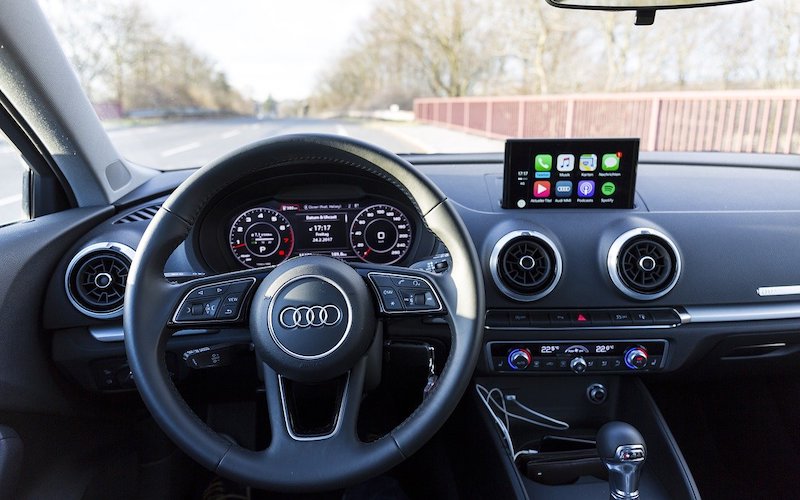With the arrival of smart speakers as favorite fixtures in the home and voice assistants like Alexa, Siri, Cortana, and Google Assistant now mainstream for smart speakers, smartphones, and in-car applications – it’s only a matter of time before voice-driven commerce from in-car infotainment systems, and even in-car marketplaces, becomes a common practice for everything from buying dinner on the commute home from work to making a grocery pickup after the Saturday soccer game.
Initial in-car voice applications include integration of Alexa and Siri into in-car infotainment and navigation systems. Amazon offers Echo Auto for the aftermarket, and Google is partnering with hardware manufacturers on a variety of integrations of Google Assistant into aftermarket devices. While these applications all leverage the possibilities of voice-command solutions for in-car infotainment, the next opportunity is to integrate commerce to create revenue for automakers, aftermarket service providers and their retail and brand partners.
In-Car Buyers. In-Car Goods. In-Car Commerce.
Voice-driven commerce is an ideal solution for the car because it enables shopping on the road with safety first – drivers can keep their hands on the wheel and eyes on the highway while accomplishing their purchasing needs. In addition, drivers are not the only prospective buyers. Passengers ranging from back-seat Uber riders and kids shuttling between school and after-school activities to co-pilot friends on the way to a music festival all represent potential buyers. Quick purchases made by parked drivers also are part of the in-car commerce future.
According to a study by PYMNTS.com and P97 Networks, the average daily commute by America’s 135 million U.S. workers represents a $230 billion in-car connected commerce opportunity. When combined with heads-up displays, or HUDs – which are currently available from most automotive manufacturers including Audi, General Motors, Lexus, and Toyota – voice assistants are a preferred input method for drivers inclined to make in-car purchases.
While any type of good or service theoretically could be purchased in a vehicle, certain use cases rise to the top in consumer surveys. These include fueling/EV charging and restaurant reservations. Additional products and services like parking, food delivery, and booking car services are also of interest to drivers seeking convenience and efficiency in their daily lives.
In-car commerce opportunities feature a couple of approaches with some available now and others just beginning to come into play. An emerging model is called feature/function-on-demand (FOD) in which automotive OEMs can ‘turn on’ onboard features like autonomous driving or electric vehicle features. These features are built into the car and can be enabled through onboard firmware. Another approach is a marketplace offering classic retail-like goods and services either in a dashboard display or HUD. Additionally, existing vehicle options include navigation and entertainment. The idea is that all options can be combined into a marketplace, enabling drivers and passengers to access all of the same products and services they are used to – plus auto-specific features – on their desktop and mobile apps. The difference, of course, is that in-car buying creates a significant potential distraction component, which is why voice assistants arguably are the best option in this channel.
More In-Car Tech Required
Voice-assisted shopping – whether in the car, on a watch, or on an online store – is not as simple once you consider voice commands replacing all the clicks made during a normal online purchase path. In the car, this behavior could potentially add some distraction and frustration, possibly even a new form of road rage: ‘in-car commerce rage.’ To plan around these issues, auto makers and system manufacturers must consider the entire customer journey from determining what to buy, researching options, checking inventory, and ultimately adding products and services to cart and payment functions when designing UX/UI solutions.
Another key consideration for voice commerce is that there are three key elements making voice to machine interpretation possible. First is the platform, or the cloud service, which is able to interpret voice commands, calculate the results in the background, and return an output by using natural language generation.
Next is the application. The application is the intermediary between the hardware and the platform and lives on a device, be it a native app on a mobile phone, an app installed in branded device (such as the Amazon Echo) or an app installed on third-party hardware (like Sonos speakers). Finally, there is the hardware. This device could either be a complex, multi-purpose piece of machinery, such as a smartphone, or a relatively dumb device, like a speaker with a few microphones and Wi-Fi functionality. For in-car commerce, the hardware must be integrated into the car.
At the moment, Amazon dominates the voice market, having brought its first Echo device to the U.S. market in mid-2015. Reportedly, the company has been building this platform since 2010 and is dedicating considerable amounts of resources. Amazon has confirmed that there are now more than 10,000 employees working with voice technology. As far as in-car commerce with voice, Amazon is experimenting with integrating Alexa technology in all sorts of devices, such as clocks and even microwaves. Alexa also is the voice technology of choice for the BMW group, which is building the technology into its vehicles. Other voice vendors such as Google and Apple will follow Amazon’s lead in pursuing voice integration into vehicles.
The In-Car Commerce Platform as Enabler
The other part of the equation for voice-assisted in-car commerce is the commerce platform itself. Online shopping is nothing new. It’s been around for more than two decades. The challenge for most retailers – automotive OEMs included – is the software platforms that ran original ecommerce sites are outdated. Designed to support fairly simple buying processes on a PC, these platforms did not have the flexibility to support new channels (like mobile and in-car commerce) or new touchpoints (like voice).
Luckily, new technologies are disrupting the stodgy enterprise ecommerce platform market. This includes software that is 100 percent API-based, meaning commerce functions like shopping carts, and product catalogs can be plugged into any front-end UI or any touchpoint like voice. Modern commerce platforms also are built on a microservices software development model, which allows automotive OEMs to differentiate offerings and business process flows without having to develop the basic commerce functionality. For OEMs building marketplaces and FOD into vehicles, this new architectural approach to commerce provides the flexibility they need to keep drivers safe, but also ensures drivers can take care of other aspects of their lives while on the road.
In-car commerce represents a significant revenue opportunity for the automotive industry and will disrupt the classic OEM/dealer/owner model in which once a car was sold, little additional revenue was possible except for branded parts and services. I’d wager to guess that just as seat belts and ventilation enabled advancements in driving comfort and safety, voice assistants will enable drivers to manage some part of their lives outside of the car while at the same time, staying safe in the car.










